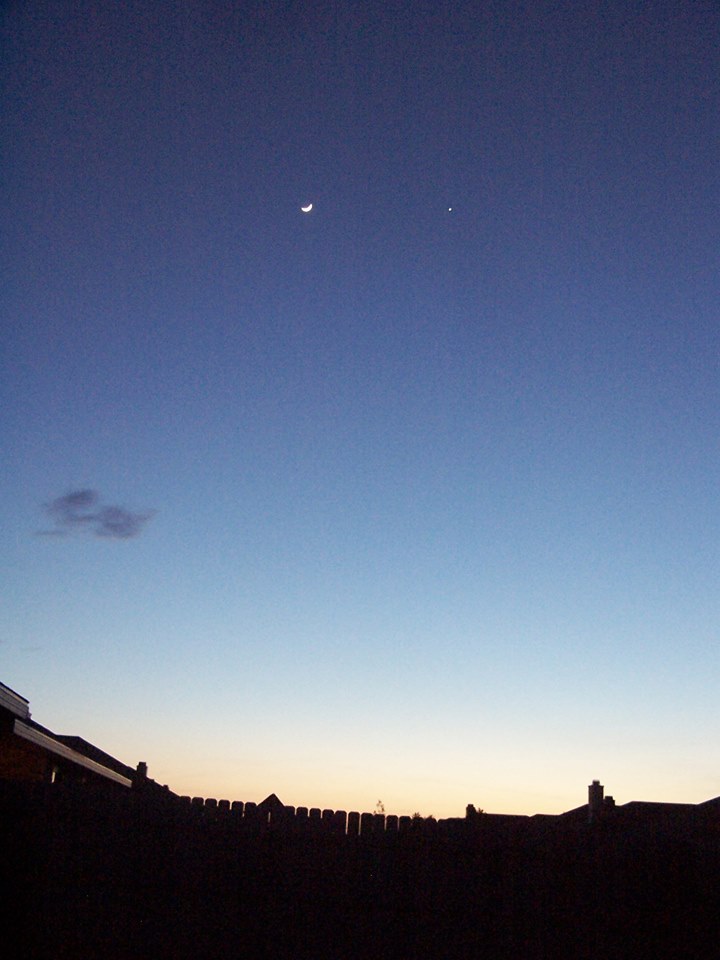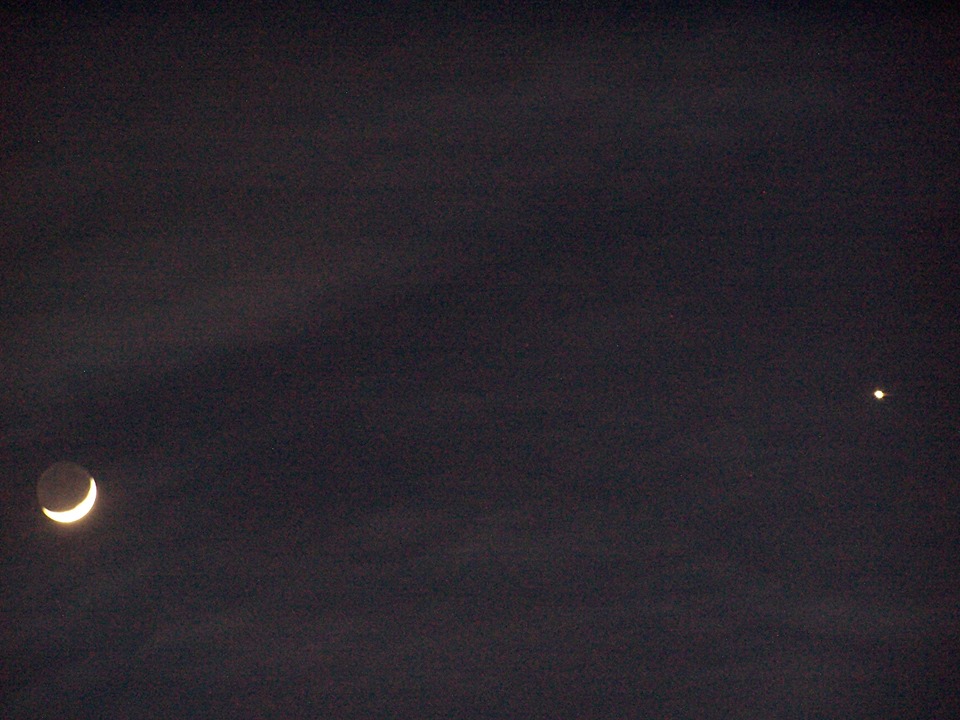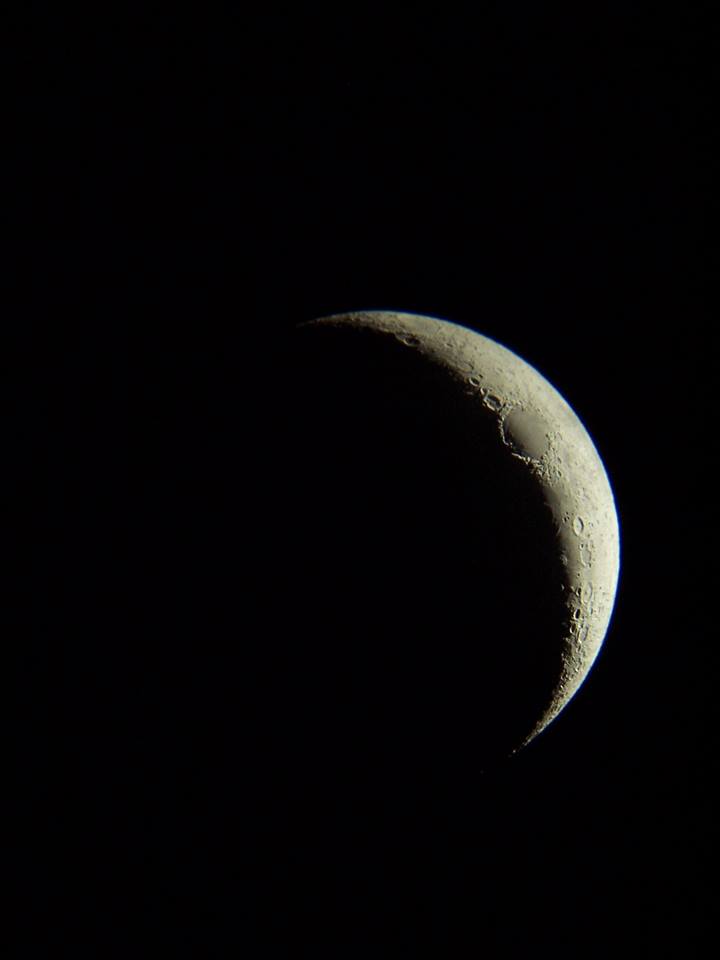| Observer: | Tom Campbell |
| Location: | Lubbock, Texas (Long: 101°56'W Lat: 33°47'N) |
| Telescope: | 8" f/6 Dobsonian |
| Eyepieces: | 1.25" Plössls - 25mm (49x), 20mm (61x), 15mm (81x), 10mm (122x), 6mm (203x), 4mm (305x) 2.0" 51.5mm (24x) |
| Seeing: | Somewhat Stable (6/10) |
| Transparency: | A few high-level clouds (7/10) |
| Temperature: | 70s |
The last couple of nights, I have been teased with a thin Moon and clear skies, but bad winds. Tonight the sky was still mostly clear, but the winds had died down considerably, so I decided to get in a bit of observing while I could.
Venus and the thin crescent Moon were near each other in the sky tonight, making for a breathtaking sight. I ended up taking several photos of the pair.


Formed during a large meteor impact, Mare Crisium (Sea of Crises) is over 345 miles in diameter. In 1969, the Soviet Luna 15 probe crashed here. Tonight, dawn had arrived on the large feature, with its rim showing up well past the terminator. This gave the Moon the appearance of the Death Star.
Another notable feature on the Moon tonight was seeing sunlight glistening off a few lunar peaks beyond the terminator near the south pole.

Appearing as beautiful to the naked eye on Earth as its namesake, Venus is one of the most hostile environments in the entire solar system. The high temperatures from being near the Sun and a runaway greenhouse effect have heated up the surface to around 900 degrees Fahrenheit. This has created a thick, cloud-covered atmosphere of primarily carbon dioxide, with traces of sulfuric acid in the clouds.
Using my telescope at high power, I was able to detect its gibbous phase. I could have used a filter to cut down on the brightness and see it more clearly, but didn't bother with it tonight.
I was still waiting for the twilight to darken into night, so I turned my telescope towards the king of the planets. Jupiter did not disappoint. The Great Red Spot (GRS) was easily visible, as were several cloud bands. The GRS is a huge storm in the upper atmosphere of Jupiter that has been around since at least 1665, and is over 18,000 miles wide (two or three Earths would fit inside it!). A narrow white band of clouds was seen separating the GRS from the Southern Equatorial Belt (SEB), making it appear to pop even more.
Also crossing Jupiter's disk was Ganymede. Although I couldn't detect the moon, I was easily able to make out its shadow. Seeing both the GRS and a shadow transit got me so excited, I ran inside to tell my wife to take a look. She was also impressed.
Planetary nebulae are the result of a sun-like star that has spent all of the hydrogen in its core and the outer layers are ejected into space while the core contracts. This will be the fate of our own Sun in a few billion years. While a horrible cataclysm to have to try to survive, from a distance, it is often a beautiful sight.
NGC 2392 is no exception. At low power, it looks like a fuzzy star near another, brighter star. Increasing the magnification to 122x revealed a bright central star with a wide circle of nebulosity surrounding it. Using averted vision, I could begin to detect a few wisps of detail, but nothing definite. I've seen it look a lot better from darker skies.
This open cluster was in the neighborhood of the Eskimo, so I thought I would take a peek. It is small and not that bright, appearing as some background glow with a sprinkling of stars. I kicked up the power to 203x, and a few more stars began to resolve, making it look better, but still not that impressive.
By pointing the scope about halfway along a line from Porrima to Beta Corvi, it is easy to find this galaxy. Right away, I could tell that galaxies were going to be hard to find tonight. Although it was obvious even at low power, it didn't pop out like it usually does. The galaxy appeared as a long thin line with a bright central core. The famous dust lane was barely detectable, even at 81x.
To confirm my suspicions, I pointed the scope at the Leo Triplet. M65 and M66 were visible, but barely. I was completely unable to spot NGC 3628, even though I have observed it on several other occasions.
Deciding to give up on galaxies this evening, I thought I'd try a globular cluster. M53 was nearby in Coma Berenices. This was more difficult to locate than I expected, because with my light pollution, none of the Coma Berenices stars were visible with the naked eye. I ended up using Porrima and Vindemiatrix as pointing stars to find it. The cluster was small, so I kicked up the power to 122x, which offered the best view (203x was mushy). The cluster appeared as a round spot of nebulosity that quickly faded out to the edges. A few stars were resolved at the edge of the cluster.
The wind was really starting to pick back up at this point. To test the conditions, I put the scope back on Jupiter. The GRS was now nearly centered on the planet, and Ganymede had just passed the edge of the disk and appeared as a bright little bulge on the side of Jupiter. The image was wiggling wildly in the wind, so I decided to pack it in for the night.